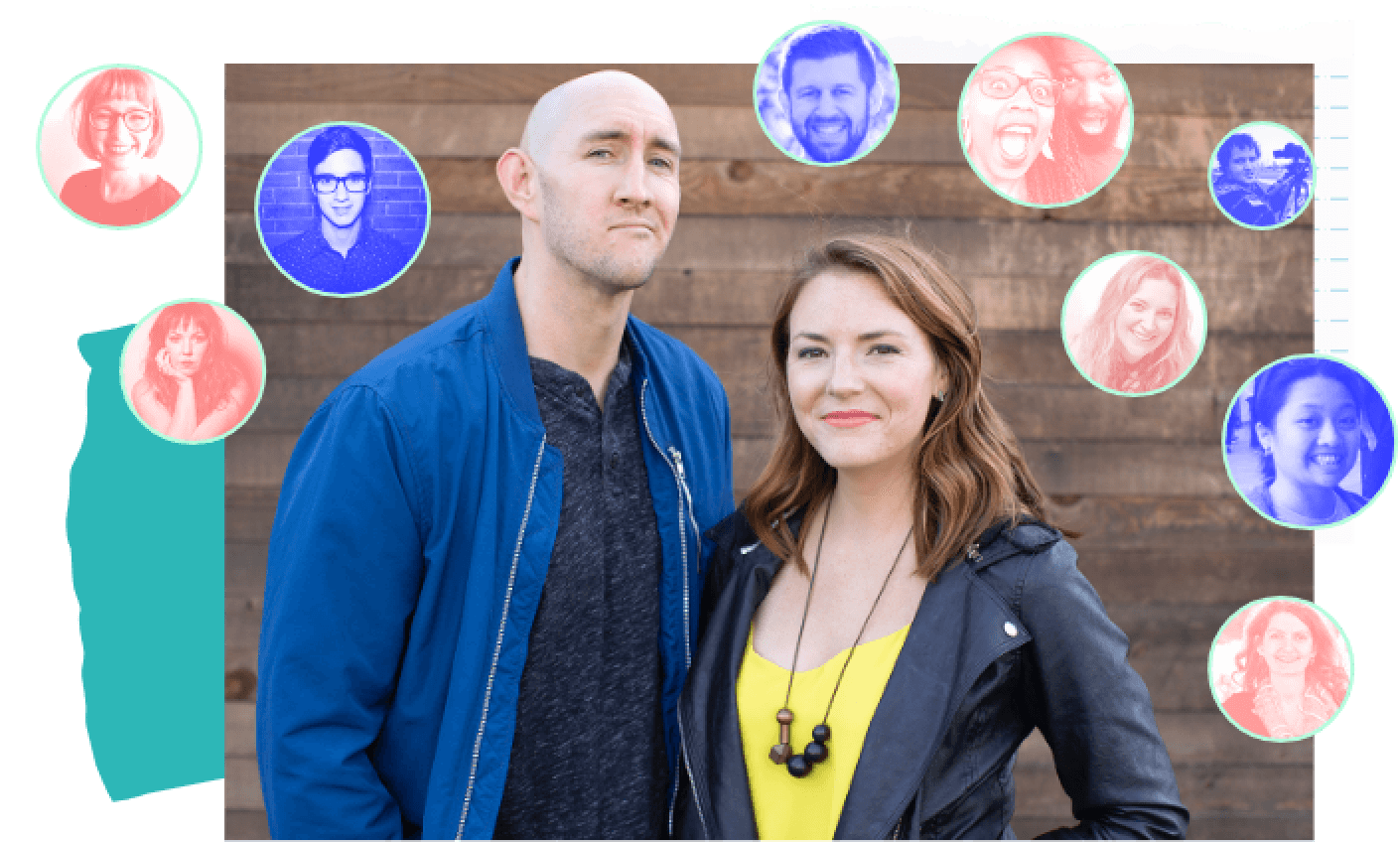In 2009, I ran into my first bad client. If you’re reading this article, I’m guessing you’ve had a bad client or customer too.
While running my IWearYourShirt (IWYS) business, I encountered clients of all shapes and sizes, but up to that point (and a count of 161 previous clients) I’d never dealt with a bad client or bad customer.
On that fateful day in 2009, I had just finished a 1-hour live video stream on Ustream.tv where I consumed nearly 10lbs of beef jerky (sorry to all my vegan friends, funny enough I’m now 100% vegan). After turning off my video camera, I popped open my email inbox and saw a message from the jerky company’s owner waiting for me.
The owner of the jerky company was unhappy with how I talked about his product, saying I didn’t ‘sell’ it enough and was disappointed overall with how the live event went. My (tired) jaw dropped.
Now, I love(d) meat. When it comes to jerky I used to eat it by the package, not the handful. Working with this client was a dream come true as I knew there’d be no need for forced enthusiasm.
Even during the live video stream, which included the owner chatting with viewers, people were saying they were going to or had already bought his jerky. I felt the event was a success, so when the client came down on me I was befuddled. In the email correspondence that followed I found myself questioning all of my choices. It seemed like all my effort was for not. But then I realized something: This was my first bad client.
I learned a bunch of valuable lessons from that experience and have gone on to work with over 2,000 different (happy) clients since then. Here are the lessons I’ve learned and how I’ve applied them to avoid dealing with potential bad clients…
Be clear with your deliverables and stand by your processes to avoid bad clients
Whether you wear t-shirts and film videos talking about beef jerky, or you’re a designer, developer, writer, etc… you have to create processes that allow you to do your best work. It’s easy to let your processes slip when a big client shows up on your doorstep (or email inbox), but the outcome of doing this is usually disastrous.
There’s a well-known story about Steve Jobs and the famous designer Paul Rand. Jobs approached Rand when he needed a logo for his company NeXT, and in typical fashion asked for multiple options to choose from. But Rand refused, saying: “No, I will solve your problem for you. And you will pay me. If you want options go talk to other people. But I will solve the problem the best way I know how. And you use it or not. That’s up to you.”
Jobs was later quoted saying of Rand, “He is one of the most professional people I have ever worked with: in the sense that he had thought through all of the formal relationship between a client and a professional such as himself.”
Now, you and I are not Paul Rand. And we are not being approached by the Steve Jobs(es?) of the world. But we are people. We do have talents. And we should absolutely create a set of values and processes that we stand by when it comes to our work. If a prospective client is not okay with those things, then that client is not the right fit for you.
If you don’t have a process in place to help you weed out bad clients, you should think about creating one. This doesn’t have to be an exhaustive 10-page document. A simple one-pager will do.
Here’s an example of some of the first questions I ask a new client:
- What are your goals with this project?
- What is the timeline for the project?
- What are the specific deliverables for the project?
- Are you okay with knock knock jokes over email?
Right away, I have all of the information I need to get started working.
You’ll have to find the questions that best represent your work and your style. For me, a question like #4 (knock knock jokes) is one of the most important ones as I want to make sure the people I work with have personality, enjoy having fun, and don’t take everything too seriously.
Look for red flags from the beginning (or, how to spot a bad client or bad customer from a mile away)
If a potential client shows resistance to filling out your one-page process document, that’s an immediate red flag.
If they do fill out your one-page process document and you still get a weird feeling in your gut about their answers, that’s a red flag. We don’t listen to our initial reactions enough and if something seems off it almost always is.
It may sound weird, but do some Internet stalking:
- Google the client’s name. Does anything negative come up in the first few pages of results? Search their @name via Twitter and see if there are any conversations that might concern you.
- You can also read some of their tweets and see if they’re the type of person who publicly complains and could cause your business harm. If they aren’t on Twitter, try to find them on other platforms (like Facebook or LinkedIn).
Another way to find out if a client is going to cause you a raging inferno of stress is to ask them for references. This sounds old school, but old school works.
Your client should be ready and willing to provide you with people who will sing their praises. Those who aren’t willing to do that fall into two categories:
- They’ve pissed everyone off and no one will vouch for them
- They aren’t willing to follow your processes, in which case that’s a huge red flag
You should also try to get a gauge of their expectations and goals of their project. If their goals don’t align with your values, it’s a red flag.
For example, let’s say you’re a designer and a farm-to-table restaurant reaches out to you to redo their website. They seem cool and they pass the test of filling out your one-page process document but on the first phone call with them they off-handedly mention they don’t really care about sustainable food and are just jumping on a trend. If sustainable food and running a business with ethical values matters to you (the designer), then this might be a red flag and a client you want to avoid.
I’m not saying you have to share all the same values as your clients, but it certainly doesn’t hurt.
Remember that your latest client didn’t exist a week ago
Too often a new client gives us shiny-object-syndrome. We get so enamored with the possibility of income, a new project, and the accolades that come along with the relationship that we neglect one simple thing:
Your next client is not your last client. They didn’t exist a few days ago and they won’t be the last person on Earth to contact you for work.
I’ve been guilty of this MANY times.
A notable company, someone I look up to, or just a cool opportunity falls in my lap. Then, for whatever reason, the project falls through. After that happens I find myself in a short-term state of unhappiness where I consider editing my values and processes to make the relationship work.
You must not edit your values or processes for clients. If you do, you’ll only end up with even more bad clients.
Those decisions will only lead to trouble down the road. Instead, I’ve learned to take a deep breath and understand that potential client didn’t ever exist on my radar before. Yes, it’s a bit of a bummer that things didn’t work out with them, but there are plenty of other client-fish swimming in the sea.
How To Fire Your Existing Bad Clients
I’m not going to sugarcoat it: Firing existing clients is not easy. But what I will tell you is that once you rip the bandaid off you’ll feel like you’ve lifted a 900-pound gorilla from your shoulders.
There are a few things to consider when going about firing a bad client:
- Don’t leave clients out to dry: You should do everything in your power to get the project you’re working on to a state of transition. That won’t mean finishing the website or app (for example), but rather reaching a specific milestone and creating transition documentation.
- Refund any money that’s been paid for future work: You shouldn’t keep a bad client’s money if it’s for work that hasn’t been done yet (no matter how badly you want to charge them an ‘a-hole client tax’).
- Have an honest, verbal conversation but don’t leave the door open: Too many times we’ll acquiesce when we start to feel bad for someone. Be firm and honest with your communication. Set a date of transition and make sure they have enough advance notice to start making changes.
- Make absolutely sure you aren’t violating any agreed-upon terms: If you signed a contract of any kind, look it over thoroughly before you attempt to end a client relationship.
Clients shouldn’t be seen as transactional, they should be seen as partnerships
Take care of your clients and they will take care of you. If you create great working relationships with people, they should want to do all your marketing for you.
Seek to solve problems for your clients and over-deliver on their goals if you can. I don’t mean work 10x more hours, but rather go out of your way to make their life easier and give them the right tools for success (however that’s determined for your business offerings).
If you can change your mindset from clients to partnerships it will make the entire working relationship easier. Instead of thinking you owe someone a certain amount of hours of work, you can shift your thinking to investing hours to help someone reach their goals. That’s where real success happens.
Happy clients pay their bills and are more likely to pay you again
Successful partnerships have the same benefits as happy clients, but also lead to referrals, additional projects, and long-term relationships.
Some of the clients from the first year of my IWearYourShirt business (2009) continue to support my new projects to this day. We respect each other and have built a solid foundation together, one that continues to be mutually beneficial year after year.







